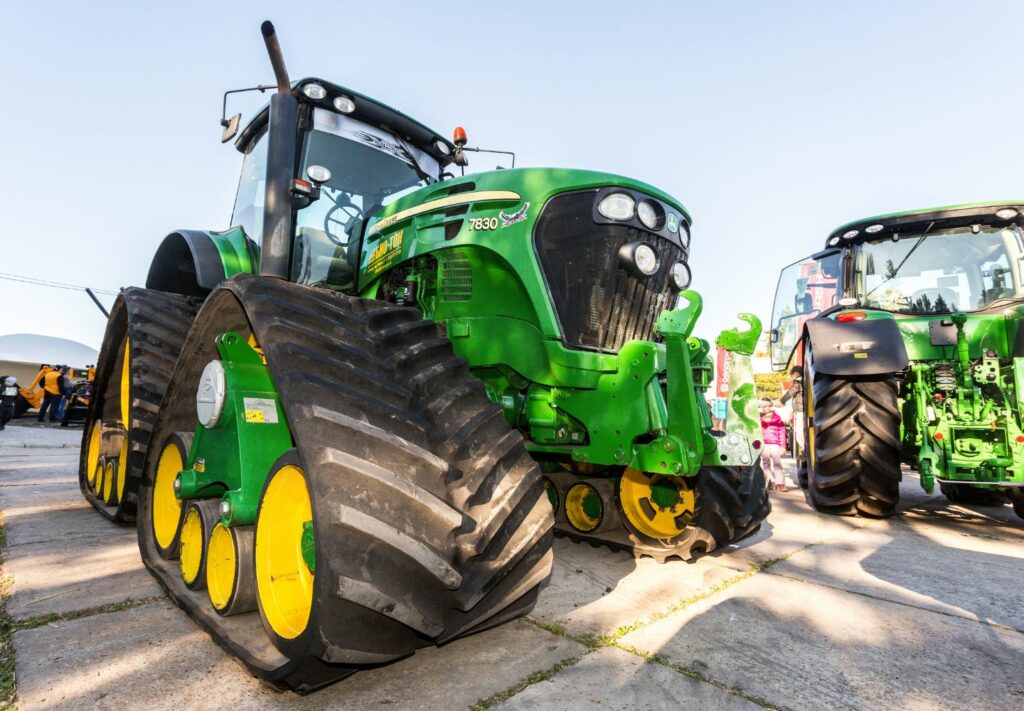Rubber Tracks vs Tyres – What’s Best For Your Industry?

For businesses in the agricultural, construction and mining industries, whether to outfit your heavy machinery with rubber tracks or tyres will depend on a number of factors. Both options have their own advantages and disadvantages depending on the machinery used and the needs of your industry.
When it comes to choosing rubber tracks or tyres, taking a close look at the most important factors including durability, site impact and cost will help you make the right decision.
Agriculture
When it comes to the agricultural industry, the choice between tyres and rubber tracks will generally depend on whether your soil tends to be wet or dry, and whether your vehicle ever needs to travel by road.
Rubber Tracks
If the area your tractor or other agricultural vehicles work with is uneven or often wet, agricultural rubber tracks are likely the best choice. This is because rubber tracks have more traction than tyres, giving a smoother experience on rough or wet fields. Ag tracks also have lower ground pressure, reducing soil compaction and rutting.
Another advantage of rubber tracks is that they will not go flat. They also offer increased durability and mobility for terrain that is more challenging. It’s worth noting that rubber tracks tend to be more expensive than tyres and will require more ongoing maintenance due to the increased number of moving parts.
Ag Tyres
Aside from the obvious benefit that agricultural tyres are less expensive for your farm machinery, tyres have a higher speed capacity. They also tend to perform better in dry conditions, so if your fields are not frequently wet, tyres may be the better option. Whether your machinery will need to travel on hard surfaces and roads is another factor to consider, as farm tyres are preferred in this case.
The disadvantages of tyres are that they are much less durable than rubber tracks, and increased pressure can damage soil and leave ruts.
Construction
Businesses in the construction industry usually have four main considerations when it comes to choosing rubber tracks or tyres for their machinery; manoeuvrability, ground impact, durability and overall cost. Your construction site is likely to make use of both tracks and tyres depending on the type of machines used and their specific purposes.
Rubber Tracks
If your construction site requires machinery with good manoeuvrability and precision, rubber tracks come out on top in most cases. The only exception to this is sites that deal with snow, in which case tyres are the better option. Rubber tracks also beat tyres if you are concerned about ground impact, as the increased surface area of the tracks means that the weight is more evenly distributed.
Rubber tracks have increased durability when working on rocky, uneven surfaces that are likely to present hazards. However, they are more expensive to replace when the time comes. Rubber tracks also require more ongoing maintenance.
Tyres
Similar to the agricultural industry, the biggest benefits of tyres include the reduced cost and higher speed capacity. If your construction site is new and ground impact isn’t a significant factor, tyres are a strong alternative to tracks.
Whether tyres are more durable than tracks depends on the terrain – for asphalt and concrete, tyres will last longer. If your site has significant uneven terrain or chunks of debris, tracks are likely the better option, as tyres may easily become punctured.
Mining
Generally, mining and construction businesses have similar considerations when it comes to choosing tyres or tracks, although there are a couple of additional factors for the mining industry.
Rubber Tracks
According to Mining Technology, rubber tracks are “ideal for mine sites compared to vehicles fitted with tyres”. This is due to the increased stability rubber tracks provide, as well as the ease of operation due to increased manoeuvrability. As rough and uneven surfaces are common in mining environments, rubber tracks are often preferred. Machines are less likely to be moving across asphalt and concrete in mining sites, reducing the need for tyres.
There are no specific drawbacks of rubber tyres for mining sites, although the general disadvantages of higher cost and increased maintenance still apply.
Tyres
While rubber tracks are often used instead of tyres in mining environments, tyres still have their place. In addition to being less expensive, tyres also give vehicles and machinery greater speed capabilities, making them good for transporting mined materials. While tyres tend to be less durable, they prove to be more versatile, being able to travel through mining sites and on the road.
Conclusion
Whether your worksite will gain more benefit from rubber tracks or tyres ultimately depends on how you use your machinery and what industry you are in. Whether you choose to go with rubber tracks or tyres, Tradefaire International has you covered. Take a look at our track warranty or browse our extensive range of tracks and tyres today.
To learn more about which option is better for your machinery or to get in touch to discuss an order, give the Tradefaire International team a call on 1300 915 078. Alternatively, you can complete our contact form to hear back from us shortly.
